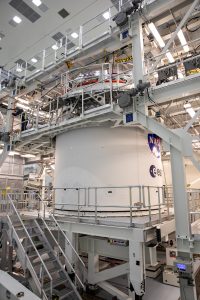
Teams with NASA’s Kennedy Space Center Exploration Ground Systems and primary contractor, Jacobs, are fueling the Orion service module ahead of the Artemis I mission. The spacecraft currently resides in Kennedy’s Multi-Payload Processing Facility alongside the Interim Cryogenic Propulsion System (ICPS), the rocket’s upper stage that will send Orion to the Moon. After servicing, these elements will be integrated with the flight components of the Space Launch System, which are being assembled in the Vehicle Assembly Building.
Technicians began loading Orion’s service module with oxidizer, which will power the Orbital Maneuvering System main engine and auxiliary thrusters on the European-built service module ahead of propellant loading. These auxiliary thrusters stabilize and control the rotation of the spacecraft after it separates from the ICPS. Once the service module is loaded, teams will fuel the crew module to support thermal control of the internal avionics and the reaction control system. These 12 thrusters steady the crew module and control its rotation after separation from the service module.
Once Orion servicing is complete, teams will fill the ICPS. This liquid oxygen/liquid hydrogen-based system will push the spacecraft beyond the Moon for the test flight under the agency’s Artemis program. In several weeks, when fueling is complete, Orion will move to the center’s Launch Abort System Facility to integrate its launch abort system, and the ICPS will move to the Vehicle Assembly Building to be stacked atop the mobile launcher.




